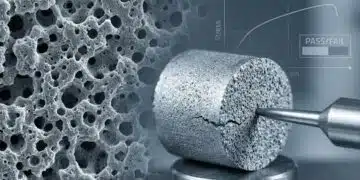SMP Sintermetalle Prometheus GmbH & Co KG (SMP) introduces energy efficient low-loss inductive components for environmental applications.
The components are fitted in inverters, power converters and high frequency converters, which are installed for example in waste and raw material recycling plants, in garbage processing, or in sewage and water treatment plants. The chokes, EMC filters, mid frequency transformers and soft magnetic cores from SMP are extremely energy-efficient, low-loss, and designed to perform flawlessly even in harsh environmental conditions.
Components in environmental applications must withstand challenging environmental conditions such as dirt, dust or moisture, extreme weather and high temperatures. In order to satisfy these requirements, the components conform to thermal class H (180°C) according to DIN EN 60085, fire protection class HL3 according to DIN EN 45545 and protection class from IP00 to IP66 according to DIN EN 60529. Thus, components from SMP can be used in PD4 environmental conditions, both inside and outside the power converter or electric plant. Cooling methods for which the components are suitable include air cooling, water cooling and free convection. To guarantee long-term operation, reliability is also a key factor in environmental applications. Consequently, many components from SMP have been in operation for more than 30 years without breakdown.
In order to ensure long-term conservation of resources and minimise ongoing operating costs, the components must maintain an optimal energy balance. The materials for the components are developed and produced by SMP especially for this purpose and are characterised by minimal eddy current and hysteresis losses. The materials are exceptionally energy-efficient, enabling the manufacture of extremely low loss, compact components with high energy density and maximum efficiency, however demanding the requirements. In order to minimise their impact on the environment, humans and wildlife, all powder-metallurgical materials are magnetostriction-free, which means that they are completely noiseless. The closed construction of the components minimises the magnetic stray field, which is not only beneficial for adjacent electronic components, it also prevents interference with the keen senses of animals in the vicinity of the plants. The compact construction with smallest possible volume and weight also offers savings with regard to the installation space required.
The range of uses for the components from SMP extends from currents up to 3000 A, frequencies up to 5 GHz, and a saturation flux density of up to 2 Tesla. All components are RoHS- and REACH-compliant and CE, EAC and UKCA certified. The materials used are UL listed.
At its factory near Karlsruhe in Germany, SMP develops and manufactures chokes, EMC filters, transformers and soft magnetic moulded parts. The soft magnetic powder composite materials used in the passive components are specially developed and produced in-house, thereby ensuring high availability. Besides the environmental engineering sector, components from SMP are used in applications in power electronics, drive technology, automation, signal processing, medical engineering, electromobility, marine engineering, railway engineering, energy generation, renewable energies and aerospace. The products are distributed worldwide, with an export rate of over 50 percent. The family-run company was founded in 1982, and since then has become a major provider of components with soft magnetic materials for industrial applications.
Summary:
- Currents: up to 3000 A
- Saturation flux density: up to 2 T
- Frequency: DC to 5 GHz
- Thermal class: H (180°C) according to DIN EN 60085
- Protection class: IP00 to IP66 according to DIN EN 60529
- Fire protection class: HL3 according to DIN EN 45545
- Cooling methods: free convection, air cooling, water cooling






























